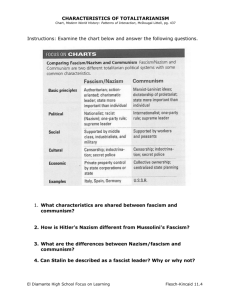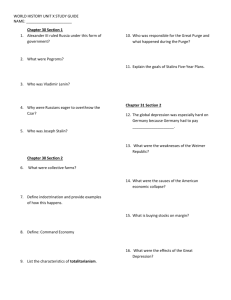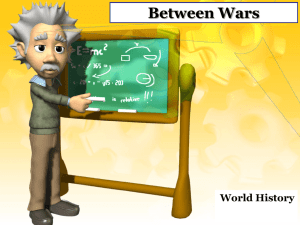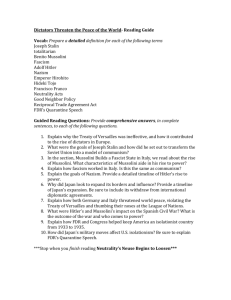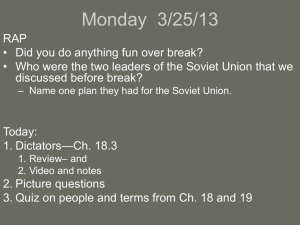Fascism Rises in Europe - Methacton School District
advertisement
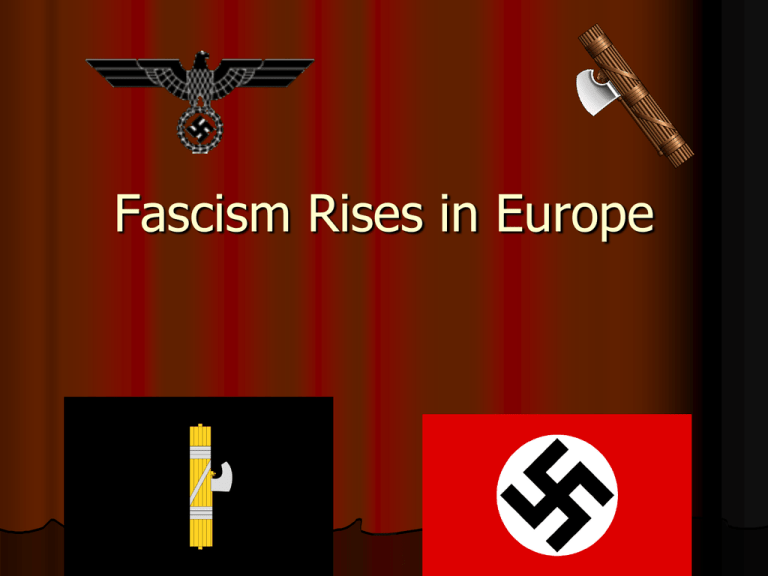
Fascism Rises in Europe Introduction World War I, millions of people lost faith in democratic government. Fascism. Fascists promised to revive the economy, punish those responsible for hard times, and restore order and national pride. Government establishes complete control of all aspects of the state (political, military, economy, social, cultural) Highly nationalistic (flags, salutes, rallies, uniforms) Strict controls and laws Military state (secret police, army, military) Censorship (opposing literature and ideas) Propaganda (media – radio, newspapers, posters) One leader (dictator); charismatic Total conformity of people to ideas and leader Terror and Fear Nazism Totalitarianism Communism Fascism Fascism vs. Communism Differences Fascism Extremely nationalistic (Fascism is for the good of a particular country alone.) Does not seek a “classless society”. Made up of aristocrats, industrialists, war veterans, and lower middle class. Communism Internationalistic (Communists believe their system should spread throughout the world.) Seeks a “classless society” Made up of urban working lower classes (Russia) and peasants (China). Fascism AND Communism Similarities Both were ruled by dictators. Both allowed only one-party rule. Both denied individual rights. In both, the state was supreme. Neither practiced democracy. Both replaced religion with some kind of competing belief system (atheism—in the case of the communists; religion of racial superiority—in the case of the Nazis) Social • Cultural Supported by middle class, Industrialists, and military Chief Examples • Italy • Spain • Germany • Censorship • Indoctrination • Secret police Fascism Basic Principles Political • nationalist • racist (Nazism) • one-party rule • supreme leader Economic • economic functions controlled by state corporations or state • authoritarianism • state more important than the individual • charismatic leader • action oriented I am Joseph Stalin, the leader of the Soviet Union from 1922-1953. What is Communism? • LEFT WING • based on theory by Karl Marx • revolutionary idea of a political, economic and social system that creates a “classless society” • state ownership and control of the means of production (no private ownership) • Soviet Communism or “Stalinism”, was more of a totalitarian and military state combined with elements of communism I am Benito Mussolini the leader (Il Duce) of Italy from 1922 to 1943. What is Fascism? • RIGHT WING • intense nationalism and elitism • totalitarian control • interests of the state more important than individual rights • maintain class system and private ownership Interesting Fact: Fascism name was derived from the fasces, an ancient Roman symbol of authority consisting of a bundle of rods and an ax I am Adolf Hitler the leader (der Fuhrer) or dictator of Germany from 1933 to 1945. What is Nazism? • extremely fascist , nationalistic and totalitarian • based on beliefs of the National Socialist German Workers Party • belief in the racial superiority of the Aryan, the “master race” • belief that all Germans should have “lebensraum” or living space in Europe •Violent hatred towards Jews and blamed Germany’s problems on them Japan Turns Militaristic The Depression also changed how the gov’t was run in Japan. Needing to end economic troubles, the military leaders of Japan resumed leadership with the Emperor as it’s political figurehead. Needing new resources for it’s industrial expansion, Japan began to aggressively take control of areas of China to steal resources. Mussolini Takes Control Fascism fueled by Italy’s failure to win large territorial gains at the Paris Peace Conference. Inflation and unemployment fuel Fascism. Mussolini promised to rescue Italy’s economy and rebuild armed forces. Mussolini founds the Fascist party in 1919. Economic downturn makes Fascists popular. March on Rome October 27-29, 1922 Fascist “blackshirts” march on Rome an demand that King Victor Emmanuel III put Mussolini in charge of the government. He puts Mussolini in power “legally.” Il Duce’s Leadership Mussolini was now called “Il Duce” translated “the leader. Democracy was abolished along with all opposing political parties to the Fascists. Secret police jailed political opponents. Radio and publications were forced to broadcast or public Fascist teachings. He sought to control the economy by allying Fascists with industrialist and large landowners. Fascist Flag The original symbol of Fascism, in Italy fasces. This is an ancient Roman symbol of power; a bundle of sticks featuring an axe, indicating the power over life and death. through unity. Hitler Rises to Power in Germany “When Mussolini became dictator of Italy in the mid-1920s, Adolf Hitler was a little-known political leader The Rise of the Nazis Hitler investigated a small political party known as the “German Workers Party.” Hitler was impressed and joined The group later changed its name to the National Socialist German Workers Party, Nazi for short. The policies of this party formed the brand of fascism called Nazism. Symbols of Nazism The Nazi party chose the swastika as its symbol. The swastika has been used for thousands of years as a symbol of power. The SA or “Brownshirts” The Nazis militia called the Sturmabteilung “storm detachment” or “storm troopers.” also called “Brownshirts” The SA was mostly made up of working class Nazis. Beer Hall Putsch Hitler was chosen as the Führer (the leader). plotted to seize power in Munich on November 8, 1923. Hitler wanted to use Munich as a base to overthrow the government in Berlin. This was called the Beer Hall Putsch. The attempted coup failed and Hitler was tried for treason and sentenced to five years in prison. He only served nine months of that sentence. Mein Kampf (My Struggle) Written in prison. The book set forth his beliefs and goals for Germany. He asserted Germans were a “master race.” outrage over the Versailles Treaty. “lebensraum” or “living space. Hitler Becomes Chancellor The Nazis were the largest political party in Germany by 1932. Conservative leaders advised President Paul von Hindenburg to name Hitler chancellor thinking they could control him. Hindenburg appointed Hitler chancellor in January 1933. Reichstag Fire Hitler immediately called for new elections. Fire destroyed the Reichstag (parliament) building six days before the election. The Nazis blamed the Communists for this fire. The Nazis won a majority of votes The Reichstag Fire Decree The Reichstag Fire Decree abolished civil rights protections. The text reads: § 1. Articles 114, 115, 117, 118, 123, 124 and 153 of the Constitution of the German Reich are suspended until further notice. It is therefore permissible to restrict the rights of personal freedom [habeas corpus], freedom of opinion, including the freedom of the press, the freedom to organize and assemble, the privacy of postal, telegraphic and telephonic communications, and warrants for house searches, orders for confiscations as well as restrictions on property, are also permissible beyond the legal limits otherwise prescribed. Enabling Act of 1933 This act gave the Office of the Chancellor plenary powers (powers he could exercise without the review of the legislative branch). The law gave the Chancellor’s cabinet the power to enact their own laws apart from the Reichstag. Therefore, Hitler came to this absolute power in a “legal” manner. Hitler’s Totalitarian State Hitler banned other political parties. Hitler created the SS. The Gestapo was established as the Nazi’s secret police. Strikes were made illegal. Millions of people were put to work building up the military. The Führer Is Supreme Hitler used the press, radio, literature, painting, and film as his propaganda tools. Churches were forbidden to criticize the Nazis or the government. The Boy Scouts was abolished in Germany. School children had to join Nazi organizations like the Hitler Youth. Hitler Makes War on the Jews Hatred of Jews, anti-Semitism, was a key part of Nazi ideology. Jews were used as scapegoats for all Germany’s troubles since the end of the war. Nazis passed the Nuremberg Laws depriving Jews of most of their rights. Nuremberg Laws Prohibited marriages between Jews and German citizens. Prohibited sexual relations between Jews and German citizens. Jews were not permitted to hire German females as domestic servants under the age of 45. Jews were forbidden to display the national flag or national colors, but could display the Jewish colors identifying them as Jews. Punishment for violating these laws includes hard labor or imprisonment. Other Countries Fall to Dictators Poland: Marshal Jozef Pilsudski—seized power in 1926. Yugoslavia, Albania, Bulgaria, and Romania—kings turn to strong man rule. Argentina-Juan Peron is a fascist “strongman” Nazism in the United States German-American Bund, (earlier called the Friends of New Germany) headed by the “American Führer” Fritz Julius Kuhn. Kuhn was appointed because Hitler wanted an American citizen fronting the organization to make it look like there were Americans truly supportive of Nazi Germany. Kuhn was eventually convicted of embezzlement from his own organization when the Mayor La Guardia of New York ordered an investigation into the organization. Kuhn was arrested during World War II as an enemy agent and held in a detainment camp in Texas. He was later deported to Germany and died in Munich in 1951.
